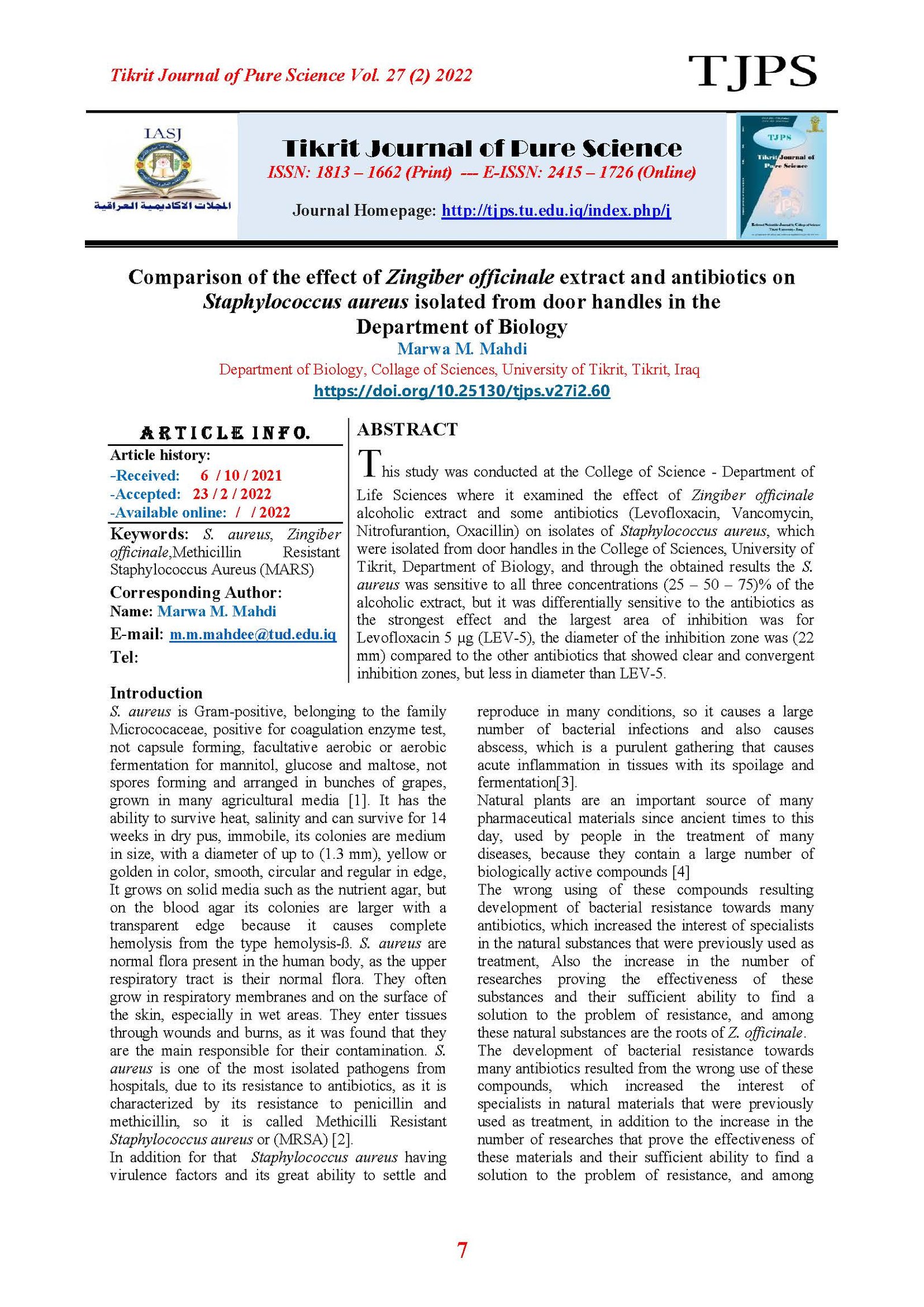Comparison of the effect of Zingiber officinale extract and antibiotics on Staphylococcus aureus isolated from door handles in the Department of Biology
Main Article Content
Abstract
This study was conducted at the College of Science - Department of Life Sciences where it examined the effect of Zingiber officinale alcoholic extract and some antibiotics (Levofloxacin, Vancomycin, Nitrofurantion, Oxacillin) on isolates of Staphylococcus aureus, which were isolated from door handles in the College of Sciences, University of Tikrit, Department of Biology, and through the obtained results the S. aureus was sensitive to all three concentrations (25 – 50 – 75)% of the alcoholic extract, but it was differentially sensitive to the antibiotics as the strongest effect and the largest area of inhibition was for Levofloxacin 5 µg (LEV-5), the diameter of the inhibition zone was (22 mm) compared to the other antibiotics that showed clear and convergent inhibition zones, but less in diameter than LEV-5.
Article Details

This work is licensed under a Creative Commons Attribution 4.0 International License.
Tikrit Journal of Pure Science is licensed under the Creative Commons Attribution 4.0 International License, which allows users to copy, create extracts, abstracts, and new works from the article, alter and revise the article, and make commercial use of the article (including reuse and/or resale of the article by commercial entities), provided the user gives appropriate credit (with a link to the formal publication through the relevant DOI), provides a link to the license, indicates if changes were made, and the licensor is not represented as endorsing the use made of the work. The authors hold the copyright for their published work on the Tikrit J. Pure Sci. website, while Tikrit J. Pure Sci. is responsible for appreciate citation of their work, which is released under CC-BY-4.0, enabling the unrestricted use, distribution, and reproduction of an article in any medium, provided that the original work is properly cited.
References
[1] Macffaddin, T.F. (2000). Biochemical test for identification B-of medical bacteria.3, Wiliams and Wilkins. Baitimor, U.S.A.
[2] Kapoor, J.; Saigal, S. and Elongavan, A. (2017). Action and Resistance Mechanisms of Antibiotics: A Guide for Clinicians. J Anaesthesiol Clin Pharmacol. 33(3):300-3-5.
[3] Singer, A. J., & Talan, D. A. (2014). Management of skin abscesses in the era of methicillin-resistant Staphylococcus aureus. New England Journal of Medicine, 370(11), 1039-1047.
[4] Vanisree, M., Lee, C.Y., Lo, S.F., Nalawade, S.M., Lin, C. and Tsay, H.S. (2004). Studies on the production of some important secondary metabolites from medicinal
[5] Grzanna, R., Lindmark, L. and frondoza, C.G. (2005). Zinger_anherbalmedicinal product with brood anti_inflammatory actions. J. Med. Food.,8: 125-132.
plants by plant tissue calture. Bot. Bull. Acad. Sin. 45:1-22
[6] Leber, A.L. (2016). Clinical Microbiology Procedures Handbook, 4th ed, vol 2. Washington DC: ASM Press
[7] Atwan, Zeina Waheed, Fatima Siwan, Ferdous Nouri Jaafar (2005). Biological efficacy test of safflower extract against spores and fungi. Basra Research Journal) operations_47,issue31, part Three,3.
[8] Koneman, E.W., Allen, S.D., Dowell, V. R; Janda, W.M; Sommer, H.A. and Winn, W.C. (1997). Color Atlas Text book of Diagnostic Microbiology. 4ed. T.B. Lippinaott comp., phila delohia Operations-47, Issue 31, Part Three, 3
[9] Al-Noman, Adiba Younes Sharif (1998). Molecular action of some plant extracts on the growth and metabolism of a number of Gram-positive and Gram-negative bacteria. Doctor's thesis - College of Science - University of Mosul.
[10] Carroll, K. C., Butel, J. S., Morse, S. A. (2016). Jawetz Melnick & Adelbergs
Medical Microbiology.27 ed. McGraw Hill Professional
[11] Chrubasik, S., Pittler, M.H. and Roufogalis, B.D. (2005). Zingiberis rhizome: Comprehensive review on the Zingiber officinale effect and efficacy effect and efficacy profiles. Phytomedicine, 12: 684-701.
[12] Hasan, M.M., Chowdhury S.P., Alam, S., Hossain, B., and Alam, M.S. (2005). Antifungal effects of plant extracts on seed- borne fungi of wheat seed regarding seed germination, seedling health and vigour index. Pak. J. Biol. Sci., 8: 1284-1289.
[13] Thamer M, J., Ahammed, A. K., & Ihsan, A. A. (2006). Antimicrobial activity of aqueous zingiber officinalis root.
